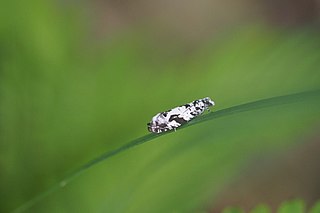
Epinotia ramella is a moth of the family Tortricidae. It is found in Europe, China, Japan, Russia and Kazakhstan.

Epinotia bilunana is a moth of the family Tortricidae. It is found in Europe, and quite widespread throughout Britain.

Epinotia solandriana is a moth of the family Tortricidae. It is found in Europe, China, Korea, Japan and Russia.

Epinotia is a very large genus of tortrix moths. It belongs to the tribe Eucosmini of subfamily Olethreutinae.

Epinotia nanana, the European spruce needleminer, is a moth of the family Tortricidae. It is found from northern and central Europe to Russia and Mongolia.

Epinotia signatana is a moth of the family Tortricidae. It is found from England and Scandinavia to the Mediterranean Sea, to eastern Russia, China, Korea, Burma and Japan.

Epinotia tenerana, the nut bud moth or alder tortricid, is a moth of the family Tortricidae.

Epinotia brunnichana is a moth of the family Tortricidae. It is found in most western, central and northern Europe, the Near East and further east to the eastern Palearctic realm, where it has been recorded from Russia, Kazakhstan, China, and Japan.

Epinotia nisella is a moth of the family Tortricidae which is found in Asia, Europe and North America. It was first described be Carl Alexander Clerck in 1759.
Epinotia thapsiana is a moth of the family Tortricidae. It was described by Philipp Christoph Zeller in 1847. It is found in the Netherlands, France, Spain, Portugal, Switzerland, Austria, Italy, Slovakia, Hungary, Slovenia, Serbia, North Macedonia, Albania, Greece, Russia, Asia Minor, Iran, Kyrgyzstan, Tajikistan, Turkmenistan, China and Korea.
Epinotia aciculana is a species of moth of the family Tortricidae. It is found in China (Heilongjiang), Japan and the Russian Far East.

Epinotia contrariana is a species of moth of the family Tortricidae. It is found in China, Mongolia, Korea, Japan and the Russian Far East.

Epinotia exquisitana is a species of moth of the family Tortricidae. It is found in China, Korea, Japan and Russia.
Epinotia majorana is a species of moth of the family Tortricidae. It is found in north-eastern China, Korea, Japan and Russia.

Epinotia nemorivaga, the bearberry bell, is a species of moth in the family Tortricidae. It is found in Europe and Asia.
Epinotia notoceliana is a species of moth of the family Tortricidae. It is found in China (Hebei) and Russia.
Epinotia pentagonana is a species of moth of the family Tortricidae. It is found in China (Jilin), Korea, Japan and Russia.
Epinotia ulmi is a species of moth of the family Tortricidae. It is found in China (Jilin), Korea, Japan and Russia.

Epinotia subocellana is a species of moth of the family Tortricidae. It is found in Asia and Europe and was first described by Edward Donovan in 1806.

Epinotia abbreviana is a moth of the family Tortricidae. It is found in Europe and was first described by Johan Christian Fabricius in 1794.














